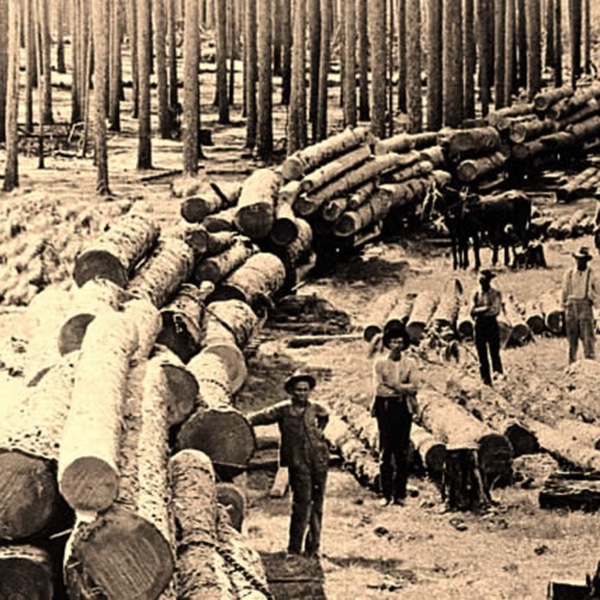Aldridge Sawmill: The Story in Numbers

Download lesson plan and included materials
Subject: Math and Social Studies
Grade: 7th
Author: Carol Schlenk, revised by Jason Terry and Mary Rodriguez (2023)
Time Duration: Two 45-minute class periods or one 90-minute block period
Objective: To practice math skills while becoming familiar with Texas' "Boom & Bust" economy and the natural history of the east Texas Piney Woods.
TEKS: Social Studies, Grade 7
- (7B), define and trace the impact of "boom-and-bust" cycles of leading Texas industries throughout the 20th and early 21st centuries such as farming, oil and gas production, cotton, ranching, real estate, banking, and computer technology
- (8C), analyze the effects of physical and human factors such as climate, weather, landforms, irrigation, transportation, and communication on major events in Texas
- (9A), identify ways in which Texans have adapted to and modified the environment and explain the positive and negative consequences of the modifications
- (21A), create and interpret thematic maps, graphs, and charts representing various aspects of Texas during the 19th, 20th, and 21st centuries
- (22A), use social studies terminology correctly
Mathematics, Grade 7
- (1A), apply mathematics to problems arising in everyday life, society and the workplace
- (4D), solve problems involving ratios, rates, and percents, including multi-step problems involving percent increase and percent decrease, and financial literacy problems
- (4G), generate equivalent forms of fractions, decimals, and percents using real-world problems, including problems that involve money
- (11B), determine the mean absolute deviation and use this quantity as a measure of the average distance data are from the mean using data set of no more than 10 data points
Materials:
- "Zones of Annual Precipitation in Texas" map (included)
- "Natural Regions and Subregions of Texas" map (included)
- Internet computer access to www.texasbeyondhistory.net/aldridge/index.html
- "Aldridge Sawmill – The Story in Numbers" student handout OR online version of handout: https://quizizz.com/admin/quiz/6547f01110ed7c453dc81b51?source=quiz_share
- Answer key to student handout
- Assorted geographical and botanical reference materials (e.g. field guides to Texas, Texas maps, travel guides, nonfiction trade books) (optional)
- Calculators (optional)
Activities and Procedures:
Part 1
Step 1: Display "Zones of Annual Precipitation in Texas" map. Explain to students that Texas is large enough to have a wide range of rainfall zones within its borders. Looking at the map, ask students which area of Texas they think is most likely to contain dense forests. Point out that the Piney Woods region receives between 45-55 inches of precipitation annually, the highest in the state, and averages about 245 days of growing season a year.
Step 2: Display the "Natural Regions and Subregions" of Texas map. Point out the Piney Woods subregion of the Gulf Coastal Plains region on the border between Texas and Louisiana. Explain that the East Texas Piney Woods is part of a pine forest that covers the entire southern United States from the Atlantic Ocean to Texas and today contains the Sam Houston, Davy Crockett, Angelina, and Sabine National Forests, as well as many commercial lumber companies and sawmills.
Step 3: Point out that at the beginning of the twentieth century, lumbering was the state's largest manufacturing enterprise, first among Texas industries in generating income, and the largest employer of labor in Texas. Today the Texas lumber industry continues to be a large and important contributor to the state economy.
Step 4: Have the students explore the Aldridge Sawmill exhibit at: www.texasbeyondhistory.net/aldridge/index.html
Part 2
Step 1: Explain that in this part of the lesson, students will learn more of the Aldridge Sawmill story that they began in Part 1.
Step 2: Distribute the student handout, "Aldridge Sawmill: The Story in Numbers" or direct them to the Quizizz link to the online version (https://quizizz.com/admin/quiz/6547f01110ed7c453dc81b51?source=quiz_share). Direct students to circle or select the correct answer for each question. Students may work alone or with a partner.
Modification: Highlight pertinent information in each question and identify functions needed to answer each question and allow calculators.
Extension Activities: Have students view the following website: www.texasbeyondhistory.net/kids/caddo/index.html. "World of the Caddo" is a children's exhibit on Texas Beyond History focused on perhaps the first "loggers" of East Texas, the Caddo Indians. In the section, "Living in Grass Houses," students can learn how these ancient people constructed huge beehive-shaped houses and temples using tall pine poles covered with bundles of grass. There is also a teacher's lesson plan keyed to "World of the Caddo."
Closure: Ask students what is meant by "Boom and Bust." Have students brainstorm examples of products that have gone through a boom-and-bust cycle in their lifetime. If time allows, have students list all the mathematical functions they used to answer the handout questions and go over correct answers with students.
Assessment: Students will be expected to answer the ten math questions with at least 70% accuracy.
Student Product: Solutions to 10 math problems.